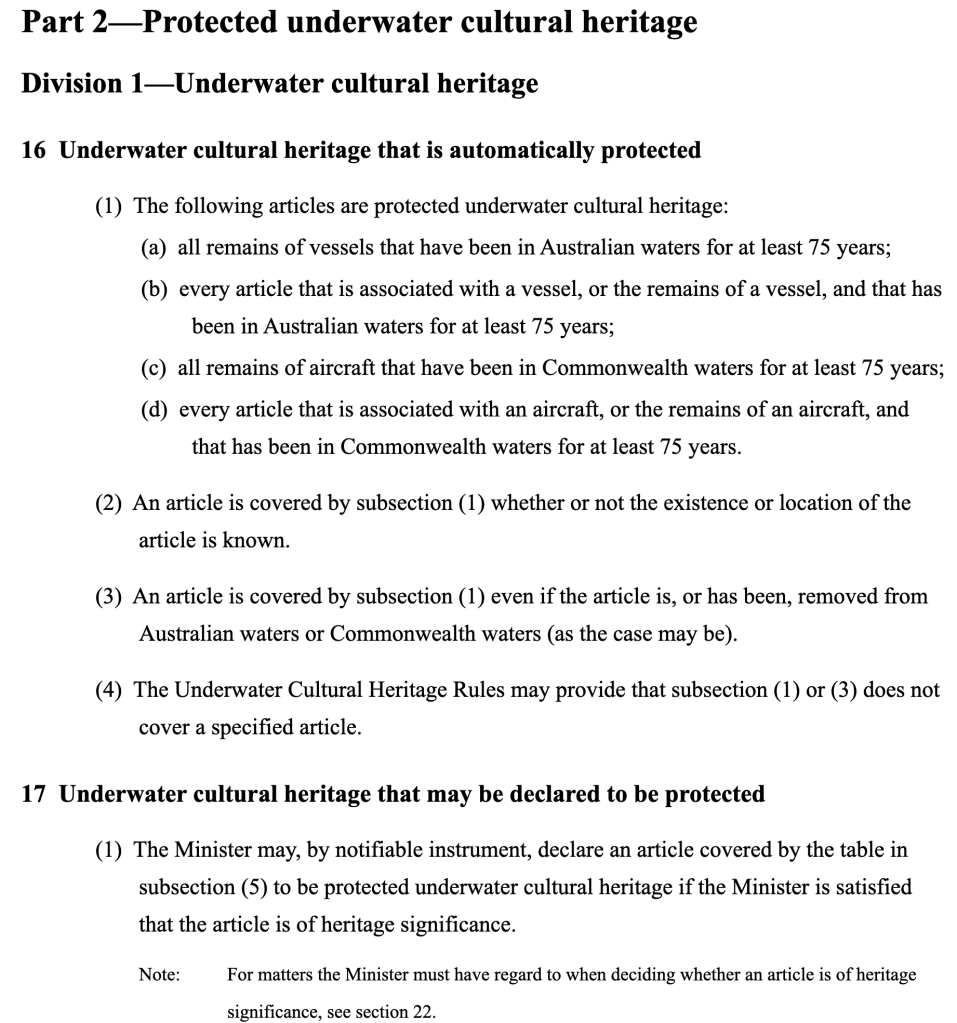There has been a lot of focus on heritage legislation recently, both on land and under water. So let’s focus on the national law that protects Australia’s Underwater Cultural Heritage (UCH):
The Underwater Cultural Heritage Act (2018).
‘This Act provides for the protection of Australia’s underwater cultural heritage.
Different kinds of articles of underwater cultural heritage are, or can be, protected, depending on the kinds of articles, their heritage significance and their location.’
Underwater Cultural Heritage Act (2018)
First, a few definitions regarding location – these are important to understand what is protected and where:
Australian waters = Coastal waters + Commonwealth waters, but not inland bodies of water such as rivers and lakes.
Coastal waters (of a State or Territory) = the water from a state’s coastal boundary out to the 3 nautical mile (nm) limit.
Commonwealth waters = Australian waters apart from Coastal waters of a State or Territory.
More detail on the different maritime zones are defined in the Act.
Second, the UCH Act offers two tiers of site protection: UCH that is automatically protected, and UCH that may be declared to be protected with ministerial approval.
So what is automatically protected by the UCH Act (2018) ? Here it is:

All vessels that have been in Australian (ie. Coastal or Commonwealth) waters for 75 years or more are automatically protected by the Act. A 75 year old sunken shipwreck whether it is found near the beach, or offshore on Australia’s continental shelf, is protected automatically by the UCH Act. Sunken aircraft located in Commonwealth waters are also protected automatically by the Act.
Heritage located under water within 0-3 nm Coastal waters zone, may also be protected by the policies of each individual State or the NT, and the details of protection vary in each State or Territory.
Indigenous archaeological sites discovered on the seabed, whether in Coastal or Commonwealth waters are not automatically protected in the same way that historic shipwrecks are protected by the UCH Act (2018).
Protection of Indigenous sites in Coastal waters would therefore defer fist to the individual State’s heritage laws to protect a site located in the 0-3 nm Coastal waters zone. The Federal UCH Act could potentially protect Indigenous sites in Australian waters (Coastal or Commonwealth waters), but only ‘if the Minister is satisfied that the article is of heritage significance’. This has yet to be tested.
Australia’s UCH Act (2018) diverges from the UNESCO Convention on the protection of Underwater Cultural Heritage (2001) which is widely referred to as global Best Practice. The UNESCO (2001) Convention defines Underwater Cultural Heritage as ‘all traces of human existence having a cultural, historical or archaeological character which have been partially or totally under water, periodically or continuously, for at least 100 years …’

There are different mechanisms to protect Indigenous heritage under water and the individual state heritage laws serve as the primary mechanism that would be protect Indigenous UCH in Coastal waters. Any Indigenous sites found in Commonwealth waters could be protected, but only with ministerial approval.
However, the Australian federal law that “provides for the protection of Australia’s underwater cultural heritage” does not automatically protect Indigenous UCH in Australian waters.
That is, unless… Indigenous material culture was present onboard a historic vessel when it sank. Then the Indigenous artefacts would be automatically protected… because of their association with the historic shipwreck.

